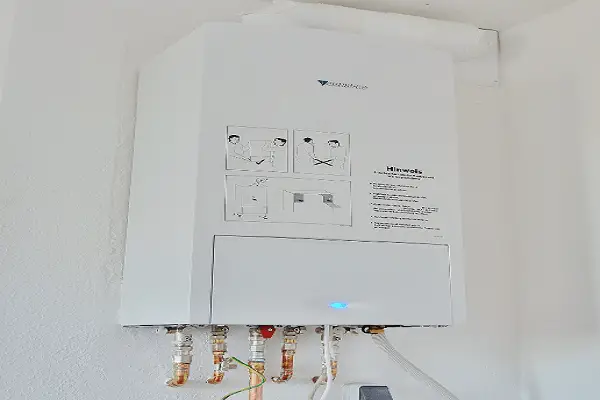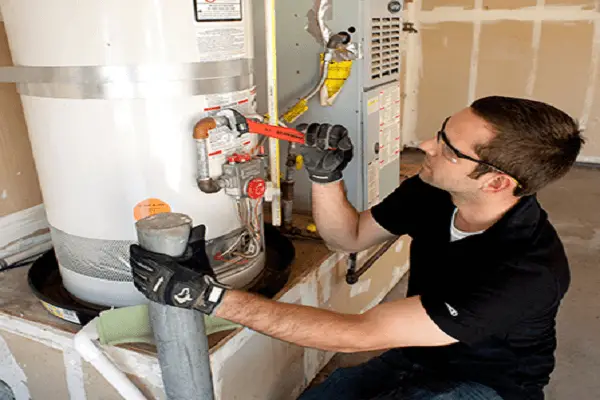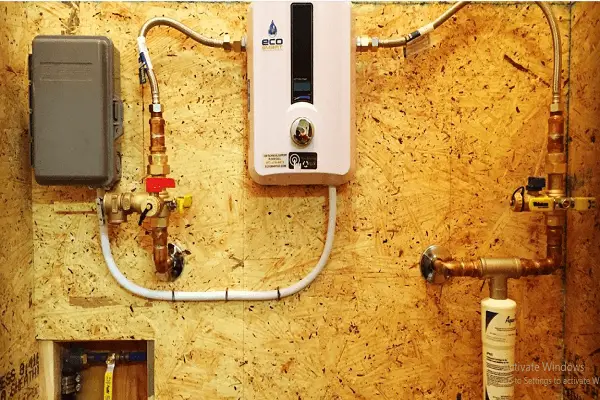Tankless water heaters, also known as on-demand or instant heaters, have grown in popularity due to their efficiency and compact design. They provide hot water when you need it, saving energy and money.
These systems, while advantageous, require proper maintenance to operate at optimum capacity. Regular upkeep prolongs the lifespan, ensures reliability, and maintains the energy efficiency of the heater.
This article focuses on the importance of regular maintenance and provides comprehensive guidance on how to keep your tankless water heater in top condition. Remember, an efficient water heater contributes to a greener environment and lower utility bills.

Contents
Why Opt for Tankless Water Heaters
Tankless water heaters come with benefits that traditional storage tank heaters cannot match.
High Energy Efficiency
Tankless systems heat water directly without the need for a storage tank. This process avoids standby energy losses associated with traditional water heaters, contributing to high energy efficiency.
Lifespan and Reliability
With proper maintenance, tankless heaters often have a longer lifespan compared to traditional ones. They are designed to last up to 20 years or more, adding to their reliability.
Compact Design and Space Saving
Their compact design makes them ideal for smaller homes or apartments. You can install them virtually anywhere in your home, saving valuable space.

Pre-Maintenance Checklist
Before initiating any maintenance task for your tankless water heater, adequate preparation is pivotal. This involves safety considerations and assembling the necessary tools for the job.
Safety Measures
First, remember to always prioritize safety. Tankless water heaters deal with electricity and hot water, and mishandling can lead to accidents. Always ensure the heater is completely turned off and disconnected from the power source. Wait for the heater to cool down before you start any maintenance tasks. Don’t forget to put on protective gloves to avoid burns from hot parts or heated water.
Necessary Tools
Various tools and supplies will be needed to effectively carry out maintenance tasks. These may include:
- A bucket for collecting water when flushing the system
- A submersible pump for running the cleaning solution through the system
- Hoses to connect the bucket to the heater
- A non-corrosive cleaner like white vinegar or a commercial descaling solution
- A soft brush for cleaning the filter
- Protective gloves for your safety
Having these tools ready will make the maintenance process smoother and more efficient.

Basic Maintenance Tasks
Regular maintenance tasks form the backbone of keeping your tankless water heater running efficiently.
Regular System Inspection
It’s important to regularly inspect the system for any visible leaks or damage. Check the external components of your heater, looking out for any signs of corrosion or damage that could hinder performance. Listen for any unusual sounds as well, as this could indicate problems with the heating elements. Catching these issues early can prevent larger, more expensive problems down the line.
Flushing the System
Flushing the system is a crucial maintenance task that helps to remove mineral deposits that can accumulate over time, especially in hard water areas. These mineral deposits can cause issues with heat transfer and water flow, leading to reduced efficiency and potential damage to the heater.
To flush your system, you’ll need to connect a hose to the drain valve of the heater, open the valve, and let the water flow into a bucket until it runs clear. Then, you’ll need to close the valve, remove the hose, and restart the heater according to the manufacturer’s instructions.

Deep Cleaning Process
To ensure your tankless water heater operates optimally, a deep cleaning process is necessary. This includes cleaning the filter and descaling the heat exchanger.
Filter Cleaning
Over time, the water filter in your tankless heater can become clogged with debris and mineral deposits, reducing water flow and potentially causing damage to the unit. Cleaning the filter involves removing it from the unit, rinsing it thoroughly under running water, and gently scrubbing it with a soft brush if necessary. Remember to replace the filter correctly after cleaning.
Descaling the Heat Exchanger
The heat exchanger is a vital component of your tankless water heater, transferring heat from the gas burners to the water flowing through the unit. However, it can become coated with scale, particularly in hard water areas, which reduces its effectiveness and can potentially lead to damage.
To descale the heat exchanger, you’ll need to flush the system with a non-corrosive cleaning solution. This process involves pumping the solution through the system using a submersible pump, allowing it to circulate for a specific time to dissolve any scale buildup, and then flushing the system with fresh water.

Monitoring Water Quality
The quality of your water plays a significant role in the efficiency and longevity of your tankless water heater.
The Role of Water Hardness
Water hardness refers to the amount of dissolved calcium and magnesium in your water. High mineral content, characteristic of hard water, can cause scale buildup in your heater, hindering its performance. Over time, this buildup can lead to damage and a reduced lifespan for your heater.
It’s important to know the hardness of your water. You can test this with a water hardness test kit or request information from your local water utility company. If you find that your water is hard, it’s crucial to take steps to manage it.
Use of Water Softeners
Water softeners can be an effective solution for hard water problems. They work by removing excess minerals from your water through a process called ion exchange. Softened water can help protect your heater from scale buildup and maintain its efficiency.
However, some softeners use salt in their processes, which can be corrosive to your heater. In such cases, consider alternatives like salt-free water conditioners or descalers.
Troubleshooting Common Issues
Even with regular maintenance, you might encounter certain issues with your tankless water heater. Understanding these problems can help you solve them quickly or decide when it’s time to call a professional.
Temperature Inconsistencies
If you’re finding that your water isn’t heating to the set temperature, this could indicate a few potential problems. It might be a faulty thermostat, which you could replace or have a professional assess. If you have a gas heater, inconsistent temperatures might indicate problems with the gas supply. Mineral buildup is another common culprit, emphasizing the importance of regular descaling.
Unexpected Shutdowns
Unexpected shutdowns can be frustrating and disruptive. These could be caused by a range of issues from power failures and gas supply problems to improper venting or overheating. If your heater frequently shuts down, it might be time to seek help from a qualified technician who can accurately diagnose and resolve the problem.
Low Water Pressure
Low water pressure can be caused by a few factors. It might be due to clogged filters, a failing heat exchanger, or a problem with the water supply. Regular maintenance, such as cleaning filters and descaling the heat exchanger, can help prevent such issues.
Professional Services
While you can handle basic maintenance tasks, certain problems may require the help of a professional.
When to Call a Pro
If you encounter issues beyond basic maintenance, it’s time to call a professional. These might include major leaks, recurring shutdowns, persistent low water pressure, or if you’re not comfortable doing the maintenance yourself. It’s better to have a professional handle these problems to avoid causing further damage to the system.
Choosing the Right Service Provider
Selecting a service provider is an important decision. Make sure to choose a provider with specific expertise in tankless water heater maintenance. Look for reviews, check their certifications, and ask if they offer any warranties or guarantees on their work. This can give you peace of mind knowing that your heater is in good hands.

Efficiency Tips
Implementing good practices can enhance the efficiency of your tankless water heater.
Routine Practices for Optimum Efficiency
Regular inspections, timely cleaning, and annual descaling can significantly improve your heater’s efficiency.
Heat Settings and Usage Patterns
Adapting your usage patterns and heat settings to match your needs can further optimize your system’s efficiency.
Environmental Impact
Maintaining your tankless water heater not only saves money but also contributes to environmental sustainability.
Reduction in Energy Use
Tankless heaters consume less energy, reducing your carbon footprint.
Lower Emission of Greenhouse Gases
Fewer emissions translate to a healthier environment, making tankless heaters a green choice.
Frequently Asked Questions
How often should I flush my tankless water heater?
Flushing should be done at least once a year. If your area has hard water, consider doing it more frequently.
Can I use a water softener with my tankless water heater?
Yes, water softeners can be used with tankless water heaters and can help prevent mineral buildup.
What is the lifespan of a tankless water heater?
With proper maintenance, a tankless water heater can last up to 20 years or more.
Conclusion
Tankless water heaters are a worthy investment. They deliver hot water on demand, save space, and offer superior energy efficiency.
Maintenance, while critical, need not be daunting. Regular system inspections, filter cleaning, and system flushing can keep your heater running smoothly. And remember, when in doubt, don’t hesitate to call in the professionals.
In essence, taking care of your tankless water heater means taking care of your comfort, your wallet, and our planet. So, let’s ensure we maintain our heaters well for a sustainable future.

